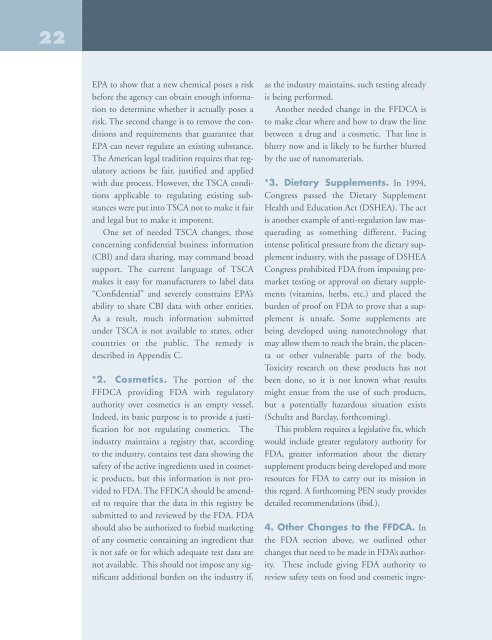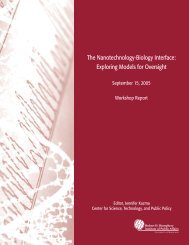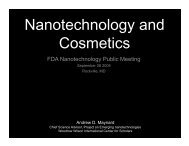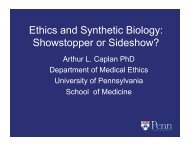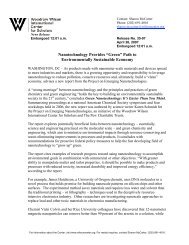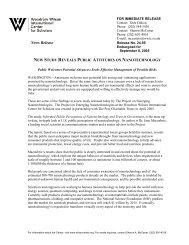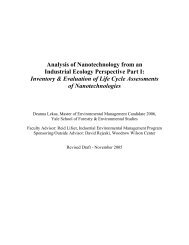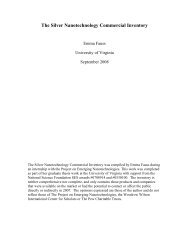nanotechnology oversight - Project on Emerging Nanotechnologies
nanotechnology oversight - Project on Emerging Nanotechnologies
nanotechnology oversight - Project on Emerging Nanotechnologies
Create successful ePaper yourself
Turn your PDF publications into a flip-book with our unique Google optimized e-Paper software.
22<br />
EPA to show that a new chemical poses a risk<br />
before the agency can obtain enough informati<strong>on</strong><br />
to determine whether it actually poses a<br />
risk. The sec<strong>on</strong>d change is to remove the c<strong>on</strong>diti<strong>on</strong>s<br />
and requirements that guarantee that<br />
EPA can never regulate an existing substance.<br />
The American legal traditi<strong>on</strong> requires that regulatory<br />
acti<strong>on</strong>s be fair, justified and applied<br />
with due process. However, the TSCA c<strong>on</strong>diti<strong>on</strong>s<br />
applicable to regulating existing substances<br />
were put into TSCA not to make it fair<br />
and legal but to make it impotent.<br />
One set of needed TSCA changes, those<br />
c<strong>on</strong>cerning c<strong>on</strong>fidential business informati<strong>on</strong><br />
(CBI) and data sharing, may command broad<br />
support. The current language of TSCA<br />
makes it easy for manufacturers to label data<br />
“C<strong>on</strong>fidential” and severely c<strong>on</strong>strains EPA’s<br />
ability to share CBI data with other entities.<br />
As a result, much informati<strong>on</strong> submitted<br />
under TSCA is not available to states, other<br />
countries or the public. The remedy is<br />
described in Appendix C.<br />
*2. Cosmetics. The porti<strong>on</strong> of the<br />
FFDCA providing FDA with regulatory<br />
authority over cosmetics is an empty vessel.<br />
Indeed, its basic purpose is to provide a justificati<strong>on</strong><br />
for not regulating cosmetics. The<br />
industry maintains a registry that, according<br />
to the industry, c<strong>on</strong>tains test data showing the<br />
safety of the active ingredients used in cosmetic<br />
products, but this informati<strong>on</strong> is not provided<br />
to FDA. The FFDCA should be amended<br />
to require that the data in this registry be<br />
submitted to and reviewed by the FDA. FDA<br />
should also be authorized to forbid marketing<br />
of any cosmetic c<strong>on</strong>taining an ingredient that<br />
is not safe or for which adequate test data are<br />
not available. This should not impose any significant<br />
additi<strong>on</strong>al burden <strong>on</strong> the industry if,<br />
as the industry maintains, such testing already<br />
is being performed.<br />
Another needed change in the FFDCA is<br />
to make clear where and how to draw the line<br />
between a drug and a cosmetic. That line is<br />
blurry now and is likely to be further blurred<br />
by the use of nanomaterials.<br />
*3. Dietary Supplements. In 1994,<br />
C<strong>on</strong>gress passed the Dietary Supplement<br />
Health and Educati<strong>on</strong> Act (DSHEA). The act<br />
is another example of anti-regulati<strong>on</strong> law masquerading<br />
as something different. Facing<br />
intense political pressure from the dietary supplement<br />
industry, with the passage of DSHEA<br />
C<strong>on</strong>gress prohibited FDA from imposing premarket<br />
testing or approval <strong>on</strong> dietary supplements<br />
(vitamins, herbs, etc.) and placed the<br />
burden of proof <strong>on</strong> FDA to prove that a supplement<br />
is unsafe. Some supplements are<br />
being developed using <str<strong>on</strong>g>nanotechnology</str<strong>on</strong>g> that<br />
may allow them to reach the brain, the placenta<br />
or other vulnerable parts of the body.<br />
Toxicity research <strong>on</strong> these products has not<br />
been d<strong>on</strong>e, so it is not known what results<br />
might ensue from the use of such products,<br />
but a potentially hazardous situati<strong>on</strong> exists<br />
(Schultz and Barclay, forthcoming).<br />
This problem requires a legislative fix, which<br />
would include greater regulatory authority for<br />
FDA, greater informati<strong>on</strong> about the dietary<br />
supplement products being developed and more<br />
resources for FDA to carry out its missi<strong>on</strong> in<br />
this regard. A forthcoming PEN study provides<br />
detailed recommendati<strong>on</strong>s (ibid.).<br />
4. Other Changes to the FFDCA. In<br />
the FDA secti<strong>on</strong> above, we outlined other<br />
changes that need to be made in FDA’s authority.<br />
These include giving FDA authority to<br />
review safety tests <strong>on</strong> food and cosmetic ingre-


